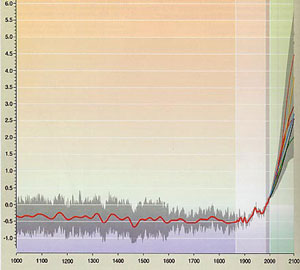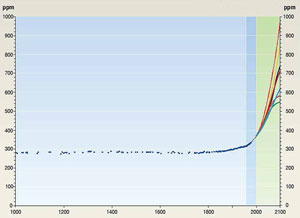 > English > Climate Encyclopaedia > People Changing Climate > basics > 1. Man-made climate change? > - What is happening?
> English > Climate Encyclopaedia > People Changing Climate > basics > 1. Man-made climate change? > - What is happening?
|
How are
|
|
|
Some of this warming, especially that which took place early in the 1900s, may be due to natural causes – such as changes in the amount of sunlight (solar radiation) that reaches the Earth. However, evidence suggests that most of the temperature increase over the last 30 to 50 years has been caused by man-made emissions of greenhouse gases. |
|
|
|
There are many different kinds of greenhouse gases. Most of the manmade contribution to the greenhouse effect is due to emissions of carbon dioxide (CO2). Carbon dioxide occurs naturally in the atmosphere but the concentration of CO2 has increased dramatically since the Industrial Revolution. This increase is mostly, if not completely, caused by people. Other greenhouse gases such as methane (CH4) have also increased. The atmosphere now also contains several greenhouse gases that do not occur naturally in the atmosphere and can only have come from human activity (read more about observed changes in the atmosphere’s concentrations of greenhouse gases here). The concentration of the important greenhouse gas, water vapor, has also increased. Increased water vapor in the air is not a direct result of emissions of water. Instead it occurs as the indirectly through emissions of other greenhouse gases. Higher temperatures in the atmosphere lead to greater evaporation from the Earth's surface and a greater capacity of the atmosphere to retain moisture.
|
|
2. MORE AND MORE CO2: Concentrations of CO2 in the atmosphere from the year 1000 to the year 2000 (ppm means parts per million, or liters CO2 per million liters of air). Scientists analyze old ice from glaciers to find out how much CO2 there was in the atmosphere. Over recent years they have also analyzed air samples taken directly from the atmosphere. Concentrations after 2000 are estimates which depend on how much CO2 people emit (see next unit). Source: IPCC (click to enlarge, 33 kB) |
|
Human influence comes in addition to all the natural factors that have always affected the Earth’s climate. The climate is affected by conditions outside the Earth’s atmosphere (for example, the intensity of the Sun and small variations in the shape of the Earth’s orbit around the Sun). The climate is also affected by natural processes in the Earth’s atmosphere, the oceans, vegetation, and snow and ice cover. These factors combine with human influence to shape the Earth’s climate. A warmer climate will change the planet in many different ways. As the Earth warms, sea levels rise. An even warmer atmosphere will lead to further sea-level rise. This is mainly because higher temperatures in the oceans cause the water to expand, which means it takes up more room. This increased need for space pushes the surface of the ocean upwards. In addition, higher temperatures in the atmosphere cause many glaciers to melt. Parts of the huge ice caps covering Antarctica and Greenland could start melting. The runoff flows into the ocean adding to the rising sea level. Ice floating in the ocean in the Artic regions near the North Pole will also melt, but since the ice is already floating in the ocean, this will not have any effect on the sea level. Higher air temperatures will also cause more water to evaporate. This may increase drought in some places and increase rainfall in others – if the water vapor creates rain clouds. A warmer atmosphere can also change prevailing wind directions and ocean currents. The warming will not be evenly distributed throughout the planet; some places may become much warmer, while other place may even become colder (read more about some observed changes in physical climate here). In Unit 2 you can read about how we expect climate to change over the next hundred years and what the consequences will be for people, animals and plants. In Unit 3 you can read about what we can do to slow down climate change.
|
About this Page:Author: Camilla Schreiner - CICERO (Centre for International Climate and Environmental Research - Oslo) - Norway.
|


